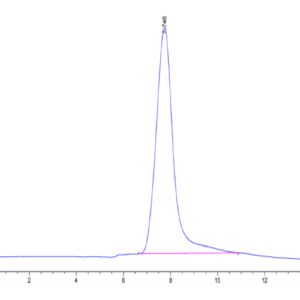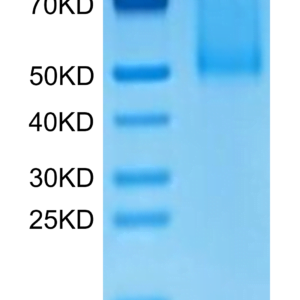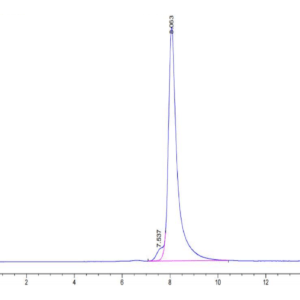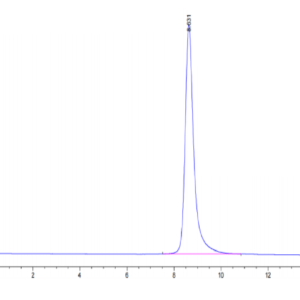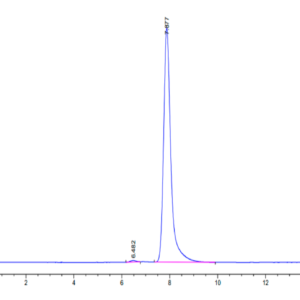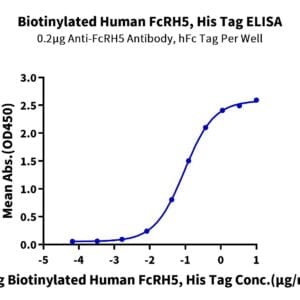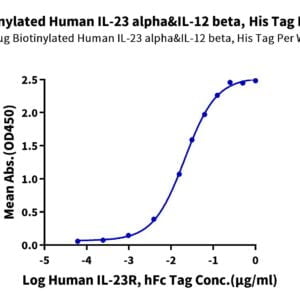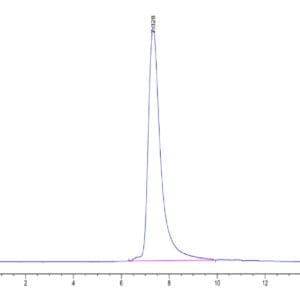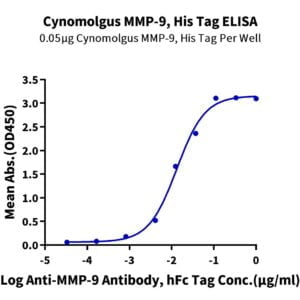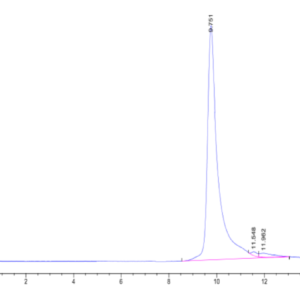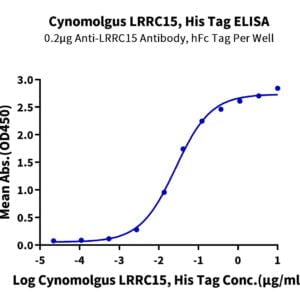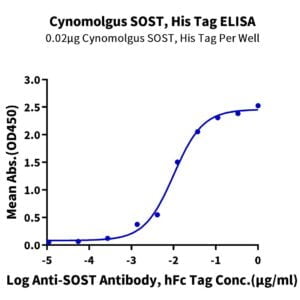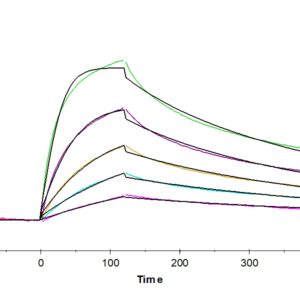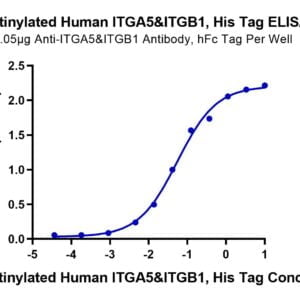| Weight | 1 lbs |
|---|---|
| Dimensions | 9 × 5 × 2 in |
| express system | HEK293 |
| product tag | C-His |
| purity | > 95% as determined by Tris-Bis PAGE;> 95% as determined by HPLC |
| background | High-mobility group box 1 (HMGB1) is a ubiquitous nuclear protein that promotes inflammation when released extracellularly after cellular activation, stress, damage or death. HMGB1 operates as one of the most intriguing molecules in inflammatory disorders via recently elucidated signal and molecular transport mechanisms. Treatments based on antagonists specifically targeting extracellular HMGB1 have generated encouraging results in a wide number of experimental models of infectious and sterile inflammation. |
| molecular weight | The protein has a predicted MW of 26 kDa. Due to glycosylation, the protein migrates to 32-36 kDa based on Tris-Bis PAGE result. |
| available size | 100 µg, 500 µg |
| endotoxin | Less than 1EU per ug by the LAL method. |
Biotinylated Human HMGB1 Protein (Primary Amine Labeling) 3473
$525.00 – $1,750.00
Summary
- Expression: HEK293
- Pure: Yes (HPLC)
- Amino Acid Range: Met1-Glu215
Biotinylated Human HMGB1 Protein (Primary Amine Labeling) 3473
| protein |
|---|
| Size and concentration 100, 500µg and lyophilized |
| Form Lyophilized |
| Storage Instructions Valid for 12 months from date of receipt when stored at -80°C. Recommend to aliquot the protein into smaller quantities for optimal storage. Please minimize freeze-thaw cycles. |
| Storage buffer Shipped at ambient temperature. |
| Purity > 95% as determined by Tris-Bis PAGE |
| target relevance |
|---|
| High-mobility group box 1 (HMGB1) is a ubiquitous nuclear protein that promotes inflammation when released extracellularly after cellular activation, stress, damage or death. HMGB1 operates as one of the most intriguing molecules in inflammatory disorders via recently elucidated signal and molecular transport mechanisms. Treatments based on antagonists specifically targeting extracellular HMGB1 have generated encouraging results in a wide number of experimental models of infectious and sterile inflammation. |
| Protein names High mobility group protein B1 (High mobility group protein 1) (HMG-1) |
| Protein family 326 |
| Function Multifunctional redox sensitive protein with various roles in different cellular compartments. In the nucleus is one of the major chromatin-associated non-histone proteins and acts as a DNA chaperone involved in replication, transcription, chromatin remodeling, V(D)J recombination, DNA repair and genome stability (PubMed:33147444). Proposed to be an universal biosensor for nucleic acids. Promotes host inflammatory response to sterile and infectious signals and is involved in the coordination and integration of innate and adaptive immune responses. In the cytoplasm functions as a sensor and/or chaperone for immunogenic nucleic acids implicating the activation of TLR9-mediated immune responses, and mediates autophagy. Acts as a danger-associated molecular pattern (DAMP) molecule that amplifies immune responses during tissue injury (PubMed:27362237). Released to the extracellular environment can bind DNA, nucleosomes, IL-1 beta, CXCL12, AGER isoform 2/sRAGE, lipopolysaccharide (LPS) and lipoteichoic acid (LTA), and activates cells through engagement of multiple surface receptors (PubMed:34743181). In the extracellular compartment fully reduced HMGB1 (released by necrosis) acts as a chemokine, disulfide HMGB1 (actively secreted) as a cytokine, and sulfonyl HMGB1 (released from apoptotic cells) promotes immunological tolerance (PubMed:23446148, PubMed:23519706, PubMed:23994764, PubMed:25048472). Has proangiogdenic activity (By similarity). May be involved in platelet activation (By similarity). Binds to phosphatidylserine and phosphatidylethanolamide (By similarity). Bound to RAGE mediates signaling for neuronal outgrowth (By similarity). May play a role in accumulation of expanded polyglutamine (polyQ) proteins such as huntingtin (HTT) or TBP (PubMed:23303669, PubMed:25549101).; Nuclear functions are attributed to fully reduced HGMB1. Associates with chromatin and binds DNA with a preference to non-canonical DNA structures such as single-stranded DNA, DNA-containing cruciforms or bent structures, supercoiled DNA and ZDNA. Can bent DNA and enhance DNA flexibility by looping thus providing a mechanism to promote activities on various gene promoters by enhancing transcription factor binding and/or bringing distant regulatory sequences into close proximity (PubMed:20123072). May have an enhancing role in nucleotide excision repair (NER) (By similarity). However, effects in NER using in vitro systems have been reported conflictingly (PubMed:19360789, PubMed:19446504). May be involved in mismatch repair (MMR) and base excision repair (BER) pathways (PubMed:15014079, PubMed:16143102, PubMed:17803946). May be involved in double strand break repair such as non-homologous end joining (NHEJ) (By similarity). Involved in V(D)J recombination by acting as a cofactor of the RAG complex: acts by stimulating cleavage and RAG protein binding at the 23 bp spacer of conserved recombination signal sequences (RSS) (By similarity). In vitro can displace histone H1 from highly bent DNA (By similarity). Can restructure the canonical nucleosome leading to relaxation of structural constraints for transcription factor-binding (By similarity). Enhances binding of sterol regulatory element-binding proteins (SREBPs) such as SREBF1 to their cognate DNA sequences and increases their transcriptional activities (By similarity). Facilitates binding of TP53 to DNA (PubMed:23063560). Proposed to be involved in mitochondrial quality control and autophagy in a transcription-dependent fashion implicating HSPB1; however, this function has been questioned (By similarity). Can modulate the activity of the telomerase complex and may be involved in telomere maintenance (By similarity).; In the cytoplasm proposed to dissociate the BECN1:BCL2 complex via competitive interaction with BECN1 leading to autophagy activation (PubMed:20819940). Involved in oxidative stress-mediated autophagy (PubMed:21395369). Can protect BECN1 and ATG5 from calpain-mediated cleavage and thus proposed to control their proautophagic and proapoptotic functions and to regulate the extent and severity of inflammation-associated cellular injury (By similarity). In myeloid cells has a protective role against endotoxemia and bacterial infection by promoting autophagy (By similarity). Involved in endosomal translocation and activation of TLR9 in response to CpG-DNA in macrophages (By similarity).; In the extracellular compartment (following either active secretion or passive release) involved in regulation of the inflammatory response. Fully reduced HGMB1 (which subsequently gets oxidized after release) in association with CXCL12 mediates the recruitment of inflammatory cells during the initial phase of tissue injury; the CXCL12:HMGB1 complex triggers CXCR4 homodimerization (PubMed:22370717). Induces the migration of monocyte-derived immature dendritic cells and seems to regulate adhesive and migratory functions of neutrophils implicating AGER/RAGE and ITGAM (By similarity). Can bind to various types of DNA and RNA including microbial unmethylated CpG-DNA to enhance the innate immune response to nucleic acids. Proposed to act in promiscuous DNA/RNA sensing which cooperates with subsequent discriminative sensing by specific pattern recognition receptors (By similarity). Promotes extracellular DNA-induced AIM2 inflammasome activation implicating AGER/RAGE (PubMed:24971542). Disulfide HMGB1 binds to transmembrane receptors, such as AGER/RAGE, TLR2, TLR4 and probably TREM1, thus activating their signal transduction pathways. Mediates the release of cytokines/chemokines such as TNF, IL-1, IL-6, IL-8, CCL2, CCL3, CCL4 and CXCL10 (PubMed:12765338, PubMed:18354232, PubMed:19264983, PubMed:20547845, PubMed:24474694). Promotes secretion of interferon-gamma by macrophage-stimulated natural killer (NK) cells in concert with other cytokines like IL-2 or IL-12 (PubMed:15607795). TLR4 is proposed to be the primary receptor promoting macrophage activation and signaling through TLR4 seems to implicate LY96/MD-2 (PubMed:20547845). In bacterial LPS- or LTA-mediated inflammatory responses binds to the endotoxins and transfers them to CD14 for signaling to the respective TLR4:LY96 and TLR2 complexes (PubMed:18354232, PubMed:21660935, PubMed:25660311). Contributes to tumor proliferation by association with ACER/RAGE (By similarity). Can bind to IL1-beta and signals through the IL1R1:IL1RAP receptor complex (PubMed:18250463). Binding to class A CpG activates cytokine production in plasmacytoid dendritic cells implicating TLR9, MYD88 and AGER/RAGE and can activate autoreactive B cells. Via HMGB1-containing chromatin immune complexes may also promote B cell responses to endogenous TLR9 ligands through a B-cell receptor (BCR)-dependent and ACER/RAGE-independent mechanism (By similarity). Inhibits phagocytosis of apoptotic cells by macrophages; the function is dependent on poly-ADP-ribosylation and involves binding to phosphatidylserine on the cell surface of apoptotic cells (By similarity). In adaptive immunity may be involved in enhancing immunity through activation of effector T cells and suppression of regulatory T (TReg) cells (PubMed:15944249, PubMed:22473704). In contrast, without implicating effector or regulatory T-cells, required for tumor infiltration and activation of T-cells expressing the lymphotoxin LTA:LTB heterotrimer thus promoting tumor malignant progression (By similarity). Also reported to limit proliferation of T-cells (By similarity). Released HMGB1:nucleosome complexes formed during apoptosis can signal through TLR2 to induce cytokine production (PubMed:19064698). Involved in induction of immunological tolerance by apoptotic cells; its pro-inflammatory activities when released by apoptotic cells are neutralized by reactive oxygen species (ROS)-dependent oxidation specifically on Cys-106 (PubMed:18631454). During macrophage activation by activated lymphocyte-derived self apoptotic DNA (ALD-DNA) promotes recruitment of ALD-DNA to endosomes (By similarity).; (Microbial infection) Critical for entry of human coronaviruses SARS-CoV and SARS-CoV-2, as well as human coronavirus NL63/HCoV-NL63 (PubMed:33147444). Regulates the expression of the pro-viral genes ACE2 and CTSL through chromatin modulation (PubMed:33147444). Required for SARS-CoV-2 ORF3A-induced reticulophagy which induces endoplasmic reticulum stress and inflammatory responses and facilitates viral infection (PubMed:35239449).; (Microbial infection) Associates with the influenza A viral protein NP in the nucleus of infected cells, promoting viral growth and enhancing the activity of the viral polymerase.; (Microbial infection) Promotes Epstein-Barr virus (EBV) latent-to-lytic switch by sustaining the expression of the viral transcription factor BZLF1 that acts as a molecular switch to induce the transition from the latent to the lytic or productive phase of the virus cycle. Mechanistically, participates in EBV reactivation through the NLRP3 inflammasome.; (Microbial infection) Facilitates dengue virus propagation via interaction with the untranslated regions of viral genome. In turn, this interaction with viral RNA may regulate secondary structure of dengue RNA thus facilitating its recognition by the replication complex. |
| Pathway 220 |
| Subellular location Nucleus. Chromosome. Cytoplasm. Secreted. Cell membrane ; Peripheral membrane protein ; Extracellular side. Endosome. Endoplasmic reticulum-Golgi intermediate compartment. Note=In basal state predominantly nuclear. Shuttles between the cytoplasm and the nucleus (PubMed:12231511, PubMed:17114460). Translocates from the nucleus to the cytoplasm upon autophagy stimulation (PubMed:20819940). Release from macrophages in the extracellular milieu requires the activation of NLRC4 or NLRP3 inflammasomes (By similarity). Passively released to the extracellular milieu from necrotic cells by diffusion, involving the fully reduced HGMB1 which subsequently gets oxidized (PubMed:19811284). Also released from apoptotic cells (PubMed:16855214, PubMed:18631454). Active secretion from a variety of immune and non-immune cells such as macrophages, monocytes, neutrophils, dendritic cells and natural killer cells in response to various stimuli such as LPS and cytokines involves a nonconventional secretory process via secretory lysosomes (PubMed:12231511, PubMed:14532127, PubMed:15944249). Secreted by plasma cells in response to LPS (By similarity). Found on the surface of activated platelets (PubMed:11154118). An increased chromatin association is observed when associated with the adenovirus protein pVII (PubMed:27362237).; Endoplasmic reticulum. Note=(Microbial infection) SARS-COV-2 ORF3A promotes HMGB1 translocation from the nucleus to the cytoplasm where it is recruited by and colocalizes with ORF3A at the endoplasmic reticulum. |
| Tissues Ubiquitous. Expressed in platelets (PubMed:11154118). |
| Structure Interacts (fully reduced HMGB1) with CXCL12; probably in a 1:2 ratio involving two molecules of CXCL12, each interacting with one HMG box of HMGB1; inhibited by glycyrrhizin (PubMed:22370717). Associates with the TLR4:LY96 receptor complex (PubMed:20547845). Component of the RAG complex composed of core components RAG1 and RAG2, and associated component HMGB1 or HMGB2 (By similarity). Interacts (in cytoplasm upon starvation) with BECN1; inhibits the interaction of BECN1 and BCL2 leading to promotion of autophagy (PubMed:20819940). Interacts with KPNA1; involved in nuclear import (PubMed:17114460). Interacts with SREBF1, TLR2, TLR4, TLR9, PTPRZ1, APEX1, FEN1, POLB, TERT (By similarity). Interacts with IL1B, AGER, MSH2, XPA, XPC, HNF1A, TP53 (PubMed:15014079, PubMed:18160415, PubMed:18250463, PubMed:19446504, PubMed:23063560, PubMed:24474694). Interacts with CD24; the probable CD24:SIGLEC10 complex is proposed to inhibit HGMB1-mediated tissue damage immune response (PubMed:19264983). Interacts with THBD; prevents HGMB1 interaction with ACER/RAGE and inhibits HGMB1 pro-inflammatory activity (PubMed:15841214). Interacts with HAVCR2; impairs HMGB1 binding to B-DNA and likely HMGB1-mediated innate immune response (By similarity). Interacts with XPO1; mediating nuclear export (By similarity). Interacts with HTT (wild-type and mutant HTT with expanded polyglutamine repeat) (PubMed:23303669). Interacts with receptor RAGE/AGER (PubMed:34743181).; (Microbial infection) Interacts with adenovirus protein pVII; this interaction immobilizes HMGB1 on chromatin, thus preventing its release from cell and subsequent inflammation activation.; (Microbial infection) Interacts with SARS-CoV-2 ORF3A protein; the interaction promotes association of HMGB1 with BECN1, promoting reticulophagy which induces endoplasmic reticulum stress and inflammatory responses and facilitates viral infection.; (Microbial infection) Interacts with influenza A virus protein NP; this interaction promotes viral replication. |
| Post-translational modification Phosphorylated at serine residues. Phosphorylation in both NLS regions is required for cytoplasmic translocation followed by secretion (PubMed:17114460).; Acetylated on multiple sites upon stimulation with LPS (PubMed:22801494). Acetylation on lysine residues in the nuclear localization signals (NLS 1 and NLS 2) leads to cytoplasmic localization and subsequent secretion (By similarity). Acetylation on Lys-3 results in preferential binding to DNA ends and impairs DNA bending activity (By similarity).; Reduction/oxidation of cysteine residues Cys-23, Cys-45 and Cys-106 and a possible intramolecular disulfide bond involving Cys-23 and Cys-45 give rise to different redox forms with specific functional activities in various cellular compartments: 1- fully reduced HMGB1 (HMGB1C23hC45hC106h), 2- disulfide HMGB1 (HMGB1C23-C45C106h) and 3- sulfonyl HMGB1 (HMGB1C23soC45soC106so).; Poly-ADP-ribosylated by PARP1 when secreted following stimulation with LPS (By similarity).; In vitro cleavage by CASP1 is liberating a HMG box 1-containing peptide which may mediate immunogenic activity; the peptide antagonizes apoptosis-induced immune tolerance (PubMed:24474694). Can be proteolytically cleaved by a thrombin:thrombomodulin complex; reduces binding to heparin and pro-inflammatory activities (By similarity).; Forms covalent cross-links mediated by transglutaminase TGM2, between a glutamine and the epsilon-amino group of a lysine residue, forming homopolymers and heteropolymers. |
| Domain HMG box 2 mediates pro-inflammatory cytokine-stimulating activity and binding to TLR4 (PubMe |
| Target Relevance information above includes information from UniProt accession: P09429 |
| The UniProt Consortium |
Data
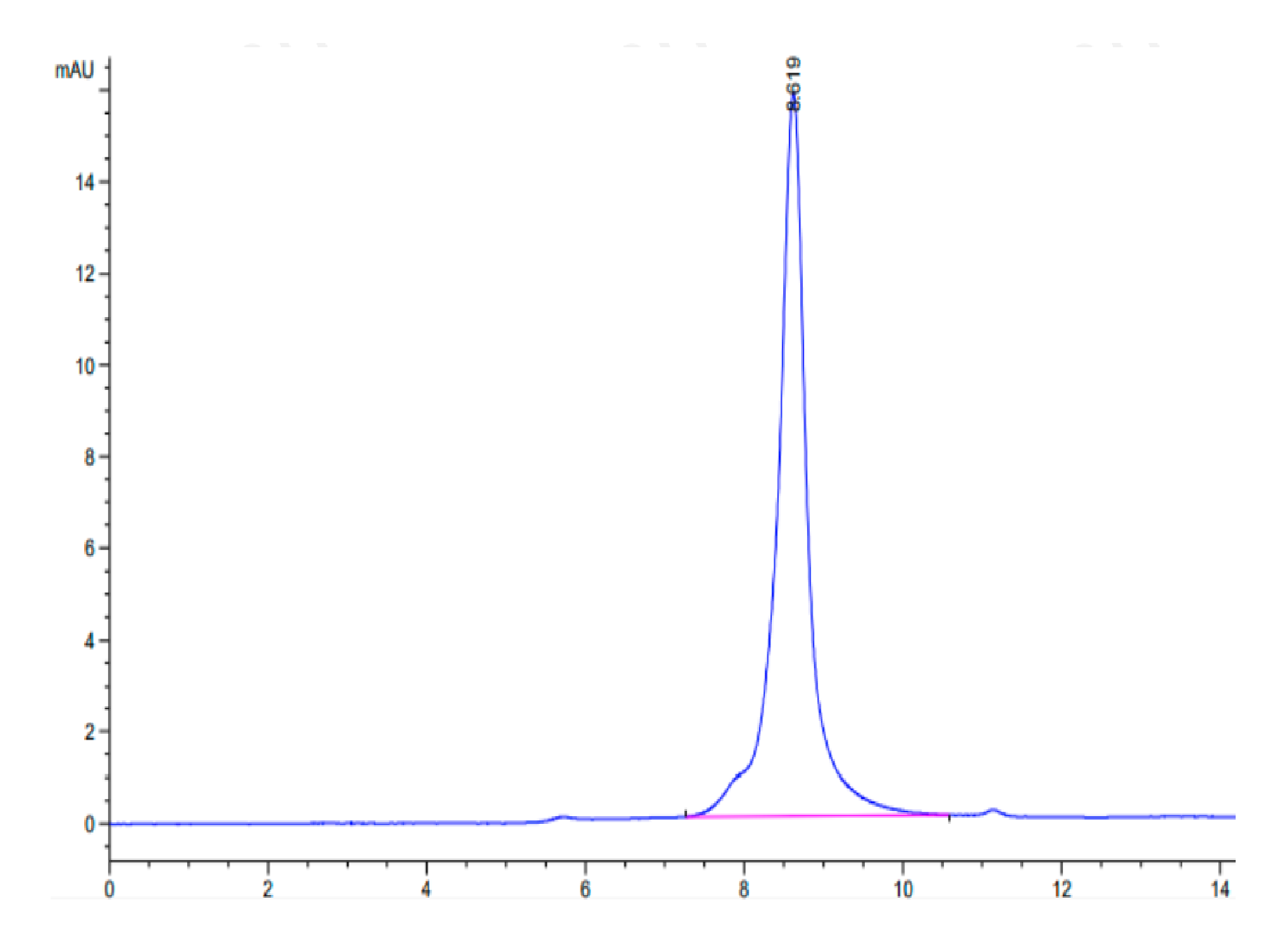 |
| The purity of Biotinylated Human HMGB1 is greater than 95% as determined by SEC-HPLC. |
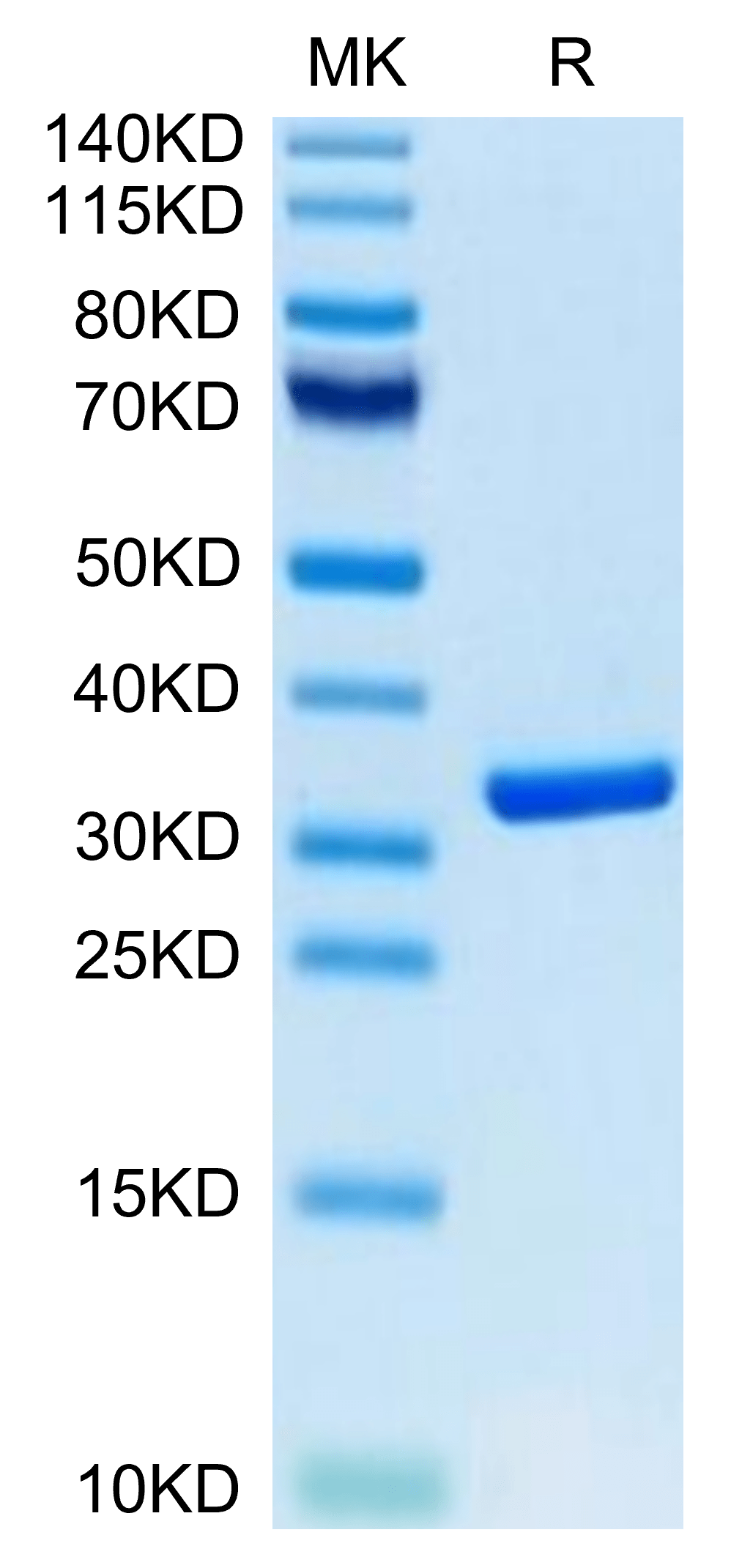 |
| Biotinylated Human HMGB1 on Tris-Bis PAGE under reduced condition. The purity is greater than 95%. |
Publications
Publications
| pmid | title | authors | citation |
|---|---|---|---|
| We haven't added any publications to our database yet. | |||
Protocols
| relevant to this product |
|---|
Documents
| # | ||
|---|---|---|
| Please enter your product and batch number here to retrieve product datasheet, SDS, and QC information. | ||
